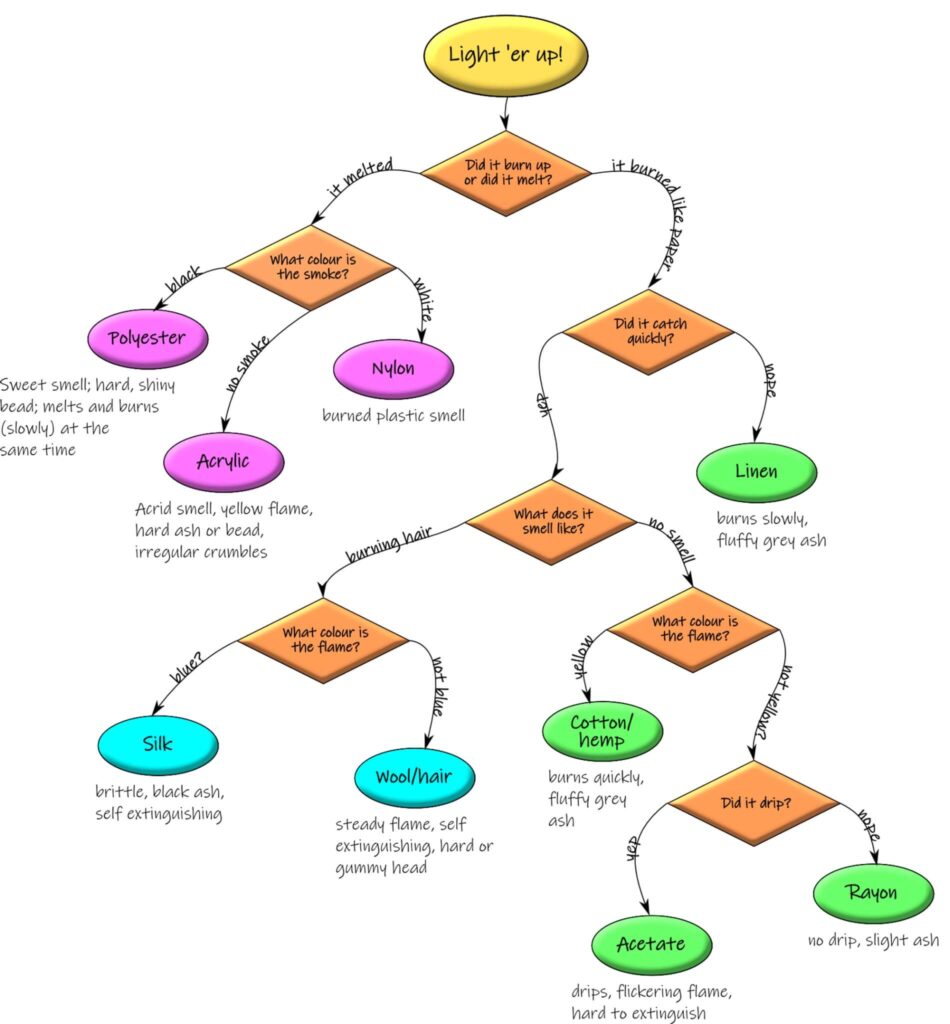If you’d like to figure out the fiber content of a mystery yarn, the quickest and easiest approach is to do a burn test.
A burn test is just what it sounds like: you light a piece of yarn on fire and record the results. Things to watch for include:
- How readily it lights
- How quickly it burns
- Whether it keeps burning without flame or self extinguishes
- How it behaves as it burns
- What it smells like as it burns
- What it leaves behind
- What color the flame is
- What color the smoke is, if any
You’ll find any number of burn charts online, most of which are designed for fabric rather than yarn. I compiled this one from a few different sources:

There are more detailed versions out there, but I find all the extra information just makes them more confusing to use, and this has all the details I need for weaving.
I’ve colour coded the fibres: green for cellulose, blue for protein, and purple for synthetic.
You’ll notice that there’s no alpaca, mohair or animal hair other than wool on this chart. They all burn like wool, so a burn test isn’t going to tell them apart. Fortunately, they also behave like wool in a mixed warp, so for weaving purposes, it doesn’t really matter which animal hair fibre your yarn is made of.
Likewise, all the forms of rayon, including Tencel®, bamboo, and viscose fall in the same place on a burn chart. Again, that’s not an issue for most weaving purposes.
Before you start
You should, of course, take reasonable safety precautions. Perform burn tests away from flammable objects and in a well ventilated area. I can tell you from experience that you should space them out as well, or else everything smells like burning plastic hair.
I recommend setting up a video camera to record while you perform the test because it all goes very quickly. It’s nearly impossible to spot the colour of the flame and of the smoke while concentrating on what it does or doesn’t smell like and also watching how fast the yarn burns or doesn’t – especially when it all takes a matter of seconds. You could burn piece after piece and watch for a different thing each time, but it saves yarn, fumes, and time to record once while paying attention to the one thing you can’t tell from the video (smell) and then watch the playback for the rest.
It works better if you hang the yarn from something rather than lay it in (for instance) a glass dish, since contact with the dish can impede the spread of the flame. You can hold the yarn in your fingers but be careful: the flames lick upwards – in some cases, very quickly! If you’re going to hold it, do so over a sink or other surface you can safely drop the burning yarn into (preferably with some water in it to put out the fire).
FYI: If you’re testing a fine yarn, you can slow down the test by bulking it up. Take a longer length of the yarn, add a lot of twist to it (with a fringe twister, for instance) until it starts to kink up, and let it ply back on itself. If even that is too skinny, start with several lengths of the yarn, twist them all together until they start to kink up, and let the whole group ply back on itself.
Theory vs. reality
Fibre burn charts make it look like everything is straightforward and easy. If only that were true! It can be tricky to decide whether a flame is yellow, not-yellow (whatever that means), or has a touch of blue. If there’s any air movement at all (as there should be, if the space is well ventilated) it’s hard to spot the smoke before it disappears. A recording can help with identifying both flame and smoke but if your nose is congested, telling a “burned plastic smell” and an “acrid smell” apart is difficult and no video is going to help.
Fortunately, it’s pretty easy to tell the fibre families apart:
- Protein fibres burn like paper rather than melting. They smell like burning hair, and self-extinguish.
- Cellulose fibres burn like paper without much smell and don’t self-extinguish.
- Synthetic fibres melt instead of or in addition to burning, and are stinky – but not like burning hair.
What’s more, I’m usually trying to decide between two options – “is this cotton or linen? is this rayon or acrylic?” – and often those two options are easy to tell apart. I rarely find myself wondering “is this acrylic or polyester,” since I’d use them both the same way anyway.
When in doubt, burn two things side by side – one you’re sure of and one you’re trying to identify – and compare the results. Linen and cotton perform pretty well the same in a burn test except for the time it takes them to burn. If you just burn a piece of linen, how can you tell whether it’s burning slowly or quickly? A 6″ piece of cottolin takes longer to burn than a 6″ piece of cotton the same thickness, and a 6″ piece of linen that thickness takes even longer. If you time the three – or better yet, burn them at the same time – it will be easy to tell them apart.
Blends
Another wrinkle is dealing with yarns that are blends of more than one fibre. Blends may do a combination of things from the different branches of the chart. What you’re looking for are the dominant characteristics: that’s the fibre that the yarn is mostly made from and therefore the fibre that will mostly affect how it acts on the loom and in the final cloth.
In the end, a partial ID is almost as good for weaving purposes as a complete one. It doesn’t matter much for a mixed warp whether you’ve got cotton or cottolin, or if your wool has some nylon in it.
Examples
Studio elf Sandra and I lit a bunch of yarn on fire and made recordings so you can see what our results looked like. You can find the entire playlist on YouTube right here.
As always, safety first, but now you know how to fire up your fibre identification knowledge!


